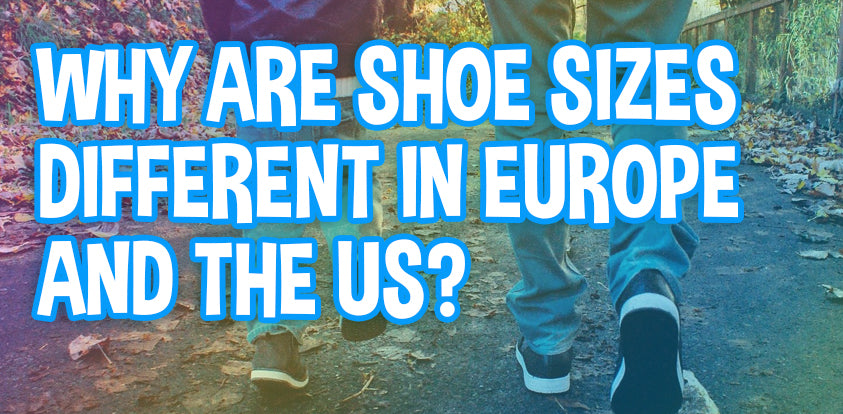
Why are Shoe Sizes Different for Kids and Adults in Europe and the US?
Share

Kids shoe sizes are all over the place. It seems like any country you go to has a different number for what is essentially the same sized shoe. There are different numbers assigned in the US, UK, Europe, Asia. Given too much thought, it can boggle the mind in a very short order.
Why are shoe sizes different for kids and adults? Why do shoe sizes for kids and adults differ between Europe and the USA? There are shoe size conversion charts, but those aren't always handy, and they don't address the how or why of our shoe size questions. We're going to concentrate our efforts on size differences between the US and Europe today, and will possibly look at some other comparisons in the future.
No matter what size your shoe is, there is no excuse for it to not smell great. Silly Feet's great smelling shoe deodorizing powder and deodorizing foot spray for kids can bring your shoes back from the brink so you don't need to worry about another round of shoe sizes during your shoe shopping. You can also bring your kid's and maybe even your own waistline back from the brink with 4 Healthy Kid's Snacks!

Shoe sizing in the US and Europe is somewhat of a messy business. Different sizes can vary between manufacturers. So how can you ensure your children have the right shoe size particularly if you do a lot of traveling? It all comes down to understanding the different parts of the foot and why the sizes are assigned as they are.
Foot Length in Shoe Sizing
Feet are measured quite differently in the US versus Europe. The US shoe sizes are based off of barleycorns, which are roughly 1/3 of an inch (around 8.47mm). European shoe sizes rely on Paris points, which equate to 2/3 of a centimeter (or 6.67mm). Both size systems are a bit antiquated in my view, but there you have it.
Foot Width and Shoe Sizes
The width or girth of a foot is generally denoted with letters. You've got N (narrow), M (medium), R (regular), W (wide). Regular would be the default size if you aren't specifying. Generally, width is taken into account more with US shoe sizes than European shoe sizes, though you can probably find a pair of wide shoes if you do some asking around.

Zero Point of Shoes
The zero point is the absolute smallest sizing of shoes available. European shoe sizes start with a 0 at the smallest size, the USA shoe sizes generally start off at 1. If we're comparing sizes then you'll need to know where to start off. You wouldn't want an extra barleycorn in your shoe now, would you?
Methods of Measure: Foot, Shoe, and Lasts
All shoes size systems refer to at least one of these characteristic lengths. The length of a foot or length of the shoe is fairly self-explanatory, but what the heck is a last? Well, a last is a foot-shaped template that some manufacturers use to ensure correct sizing. The shoe is constructed around this wooden foot or last.
There are some significant advantages to each type of measurement, so let's explore a bit further in-depth.

Foot Measurements
The main advantage to measurement being based directly on the foot is that given sizes are based directly on a person's actual body. This method is quite flexible but that also creates its own set of problems. Foot measuring is by far the least common sizing method since doing places a burden on the manufacturer to ensure that each shoe size will fit a foot of a given length.
Shoe Measurements
This type of sizing is based around the inner cavity of the finished shoe. It is certainly the most convenient method, but small manufacturing tolerances will make a difference in the final product. The length of the inner cavity can be exactly the same between shoes, but one might feel slightly more or less comfortable when these manufacturing differences and foot size/shape are taken into account.'
Last Measurements
The far and away most common form of measurement for shoe sizes is the last. It has become so commonplaces because it only stipulates the tool that was used in making the shoe. Using a last places all risk and responsibility on the consumer since it makes no promises about foot or shoe sizing.

Shoe Sizes In Europe
With all of the above information out of the way, we can finally get down to the meat and potatoes of this article. Shoe sizes in Europe are expressed based on the length of the last expressed in Paris points. The last is typically about 2 Paris points longer than the actual foot, so determining the actual foot length requires adding 2 Paris points.
Continental European shoe sizes are used throughout most of Europe and even a few Middle Eastern countries. Brazil uses this method as well but doesn't add the two points at the end like Europe does. They are essentially measuring the length of the actual foot instead of the length of the last, which makes good sense I suppose.
Shoe Sizes in USA
The US has different sizing for men, women, and children. Again, it is based on the length of the last but this time measured in barleycorn. The calculations are male shoe size = 3 x last length in inches - 24, female shoe size is the same except 23 is subtracted instead of 24. This means a man's size 10 would be a woman's size 11.
For kids shoe size there is no difference based on gender. Kids' shoe sizes are equal to men's sizes plus 12 1⁄3. Shoe stores in the US have a sizing scheme which ranges from K1 to K13, after which the adult sizes start at 1.
Final Words on US vs Europe Shoe Sizes
If it seems complicated, it is. I can only hope that I've managed to unmuddy the waters a bit. If you still end up with a shoe that doesn't quite fit then you can attempt to remedy the situation with Silly Feet's iridescent metal shoe horns! Guaranteed not to bend or break or your money back. Best of luck with your shoe shopping, wherever you might be.
